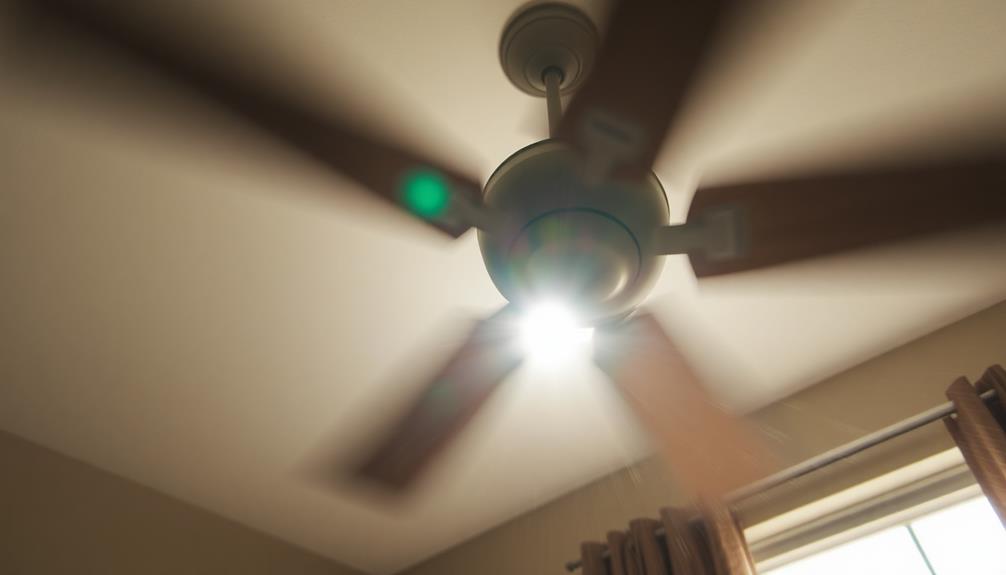If your ceiling fan is stuck on high speed, it is probably because of a faulty capacitor, a malfunctioning speed switch, or loose wiring. Begin by turning off the power at the circuit breaker for safety. Verify if the speed switch is working properly. Then examine the capacitor for any signs of wear or damage, and check for any loose or damaged wires that could be disrupting the electrical flow. Cleaning the fan blades and motor can also be beneficial. To resolve the issue, you may need to replace any faulty components. There is more to learn about maintaining the smooth operation of your ceiling fan.
Key Takeaways
- A malfunctioning speed switch may prevent speed adjustments, causing the fan to remain stuck on high speed.
- Check the capacitor for damage or wear, as a faulty capacitor can lead to high-speed defaults.
- Inspect wiring connections for looseness or damage, which can disrupt electrical flow and cause speed issues.
- Ensure the fan is clean; dust accumulation on blades or motor can affect performance and may cause it to operate at high speed.
- Turn off power at the circuit breaker before troubleshooting to ensure safety while examining components.
Ceiling Fan Basics
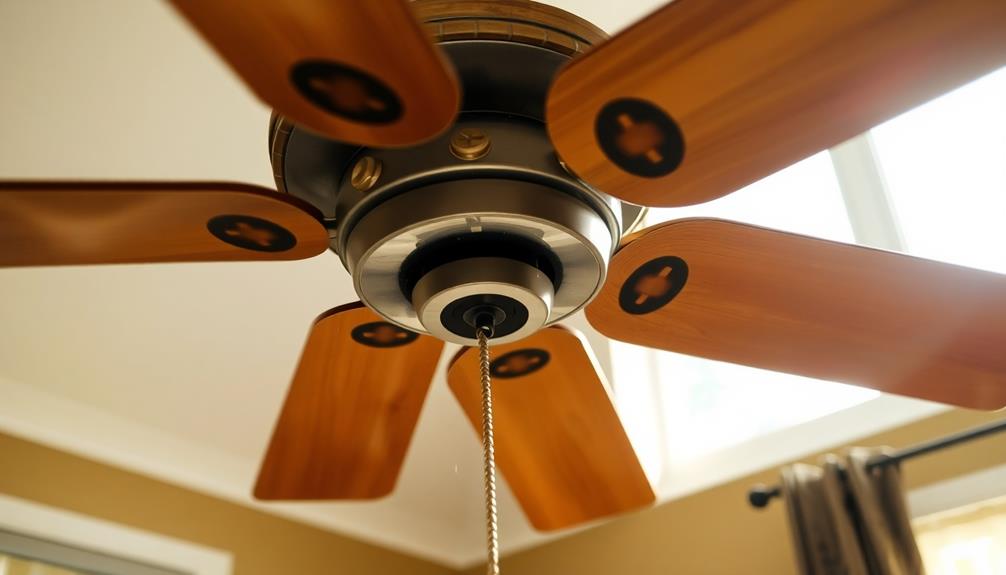
Ceiling fans are often essential in creating a comfortable indoor environment. Understanding how they function can help you maximize their benefits. They circulate air, enhancing ventilation and potentially reducing the need for air conditioning, which can save on energy costs. However, it’s important to be aware of ceiling fan safety risks, such as ensuring the fan is properly installed and that the blades remain free of obstructions. Regular maintenance, like tightening loose screws and cleaning the blades, can also help mitigate potential hazards. To further minimize ceiling fan safety risks, make sure to periodically check the wiring, especially if the fan appears to be malfunctioning or making unusual noises. Additionally, avoid hanging any objects or decorations from the fan, as this can create imbalances and increase the likelihood of accidents. Being proactive about identifying and addressing ceiling fan safety risks will ensure a safe and comfortable living space for all.
The speed settings on your ceiling fan depend on the motor's functionality, which is determined by winding configurations and capacitor values. When you increase the speed, more power is delivered to the blades, resulting in stronger airflow. Conversely, lower speeds create gentler air circulation.
The capacitor plays a vital role, providing the initial torque to start the motor and regulating the speed. By knowing these basics, you can make informed decisions about your fan's usage and maintenance, ensuring it operates efficiently and effectively in your space.
Identifying Speed Problems
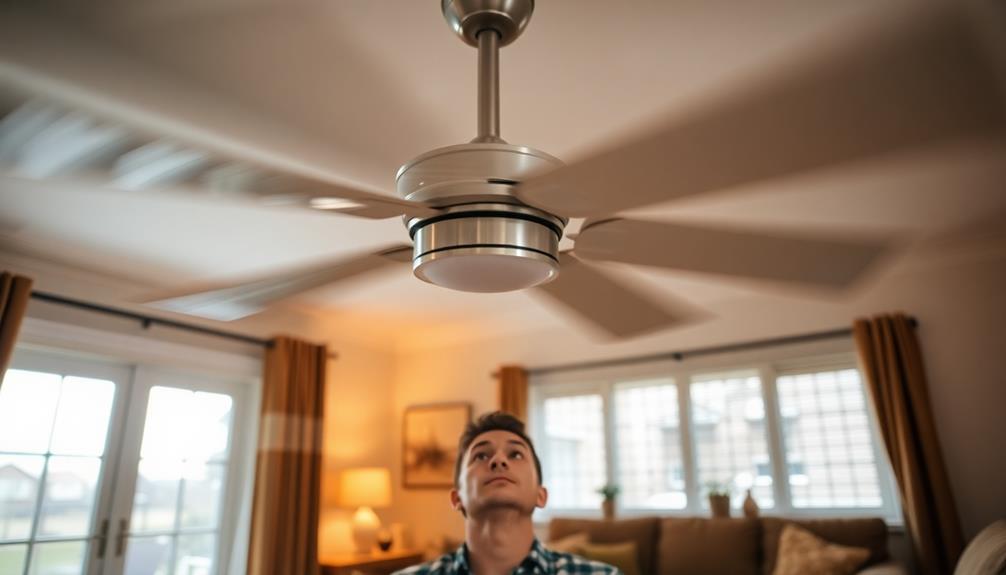
Experiencing inconsistent airflow can be frustrating and often signals underlying speed problems with your fan. You might notice your fan only runs at high speed or fails to respond to speed adjustments. This could indicate a faulty capacitor, which plays an essential role in regulating motor speed, similar to how modern fans enhance airflow, reducing reliance on air conditioning energy savings and comfort.
Additionally, check for wiring issues, as loose or damaged connections can disrupt performance. A malfunctioning speed switch might also prevent you from adjusting the fan's speed.
Troubleshooting Techniques
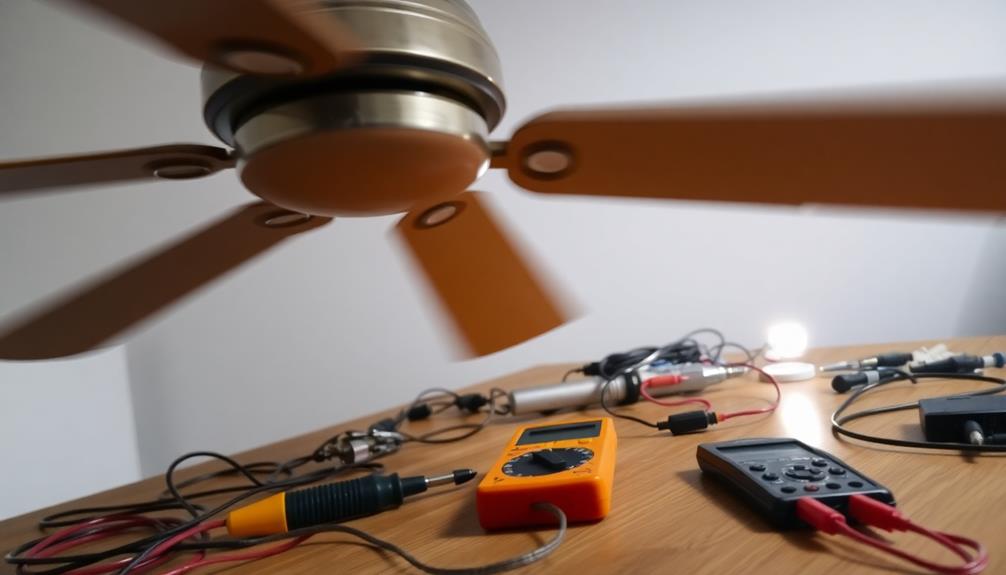
To effectively troubleshoot speed issues with your ceiling fan, start by ensuring safety precautions are in place. Turn off the power at the circuit breaker to avoid any electrical shocks.
Next, check the speed switch to see if it's functioning correctly; a faulty switch can prevent speed changes. If that seems fine, inspect the capacitor for any signs of wear or damage. You can use a multimeter to measure its capacitance.
Additionally, clean the fan blades and motor to remove any dust or debris that might impact performance.
Inspecting Electrical Connections
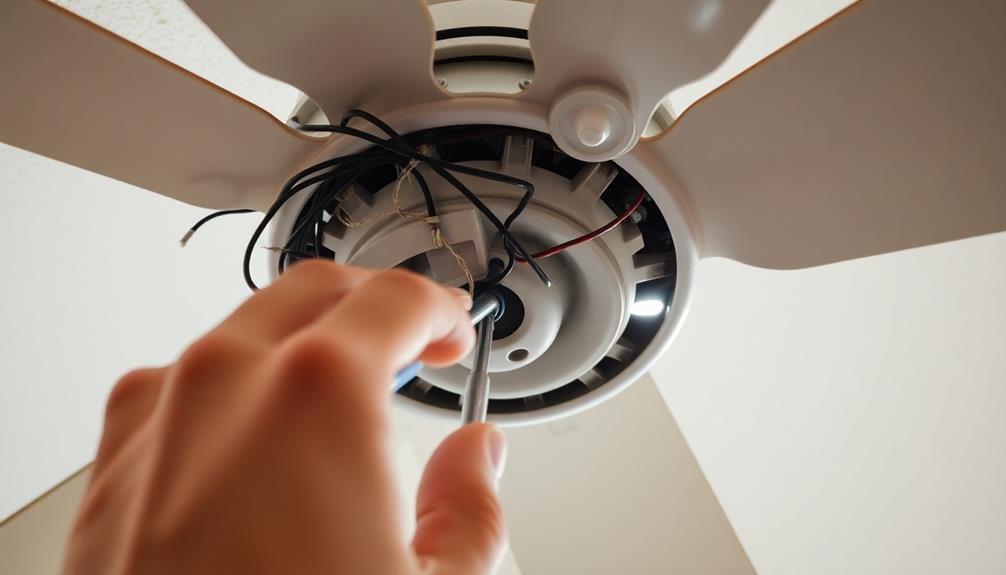
After checking the speed switch and capacitor, it's time to focus on inspecting electrical connections.
Start by turning off the power to your ceiling fan at the circuit breaker. Once it's safe, examine the wiring connections at the fan and the wall switch. Look for any loose or damaged wires that might disrupt the electrical flow.
Make certain all connections are secure, as a loose wire can cause the fan to default to high speed. If you spot any frayed or burnt wires, replace them immediately to prevent further issues.
Don't forget to check the connectors for corrosion, which can also affect performance. Properly securing these connections can guarantee your fan operates smoothly at your desired speed.
Capacitor and Motor Issues
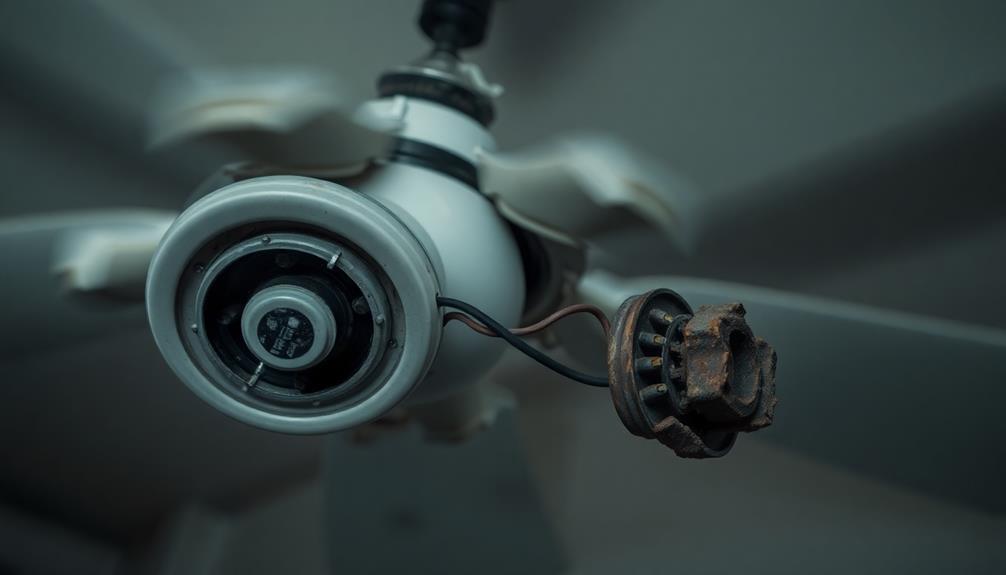
When your ceiling fan struggles with speed issues, the capacitor and motor are often at the heart of the problem. A faulty capacitor can prevent your fan from operating at varied speeds, causing it to stick on high or not work at all.
If you notice this, check the capacitor for wear or damage, as it provides vital torque and regulates speed. Additionally, the motor itself may be overheating, defaulting to high speed as a protective measure.
Inspecting both components is essential for proper functionality. If you find any signs of damage or malfunction, replacing the capacitor or motor may be necessary to restore your fan's performance and regain control over its speed settings.
Maintenance Tips for Longevity
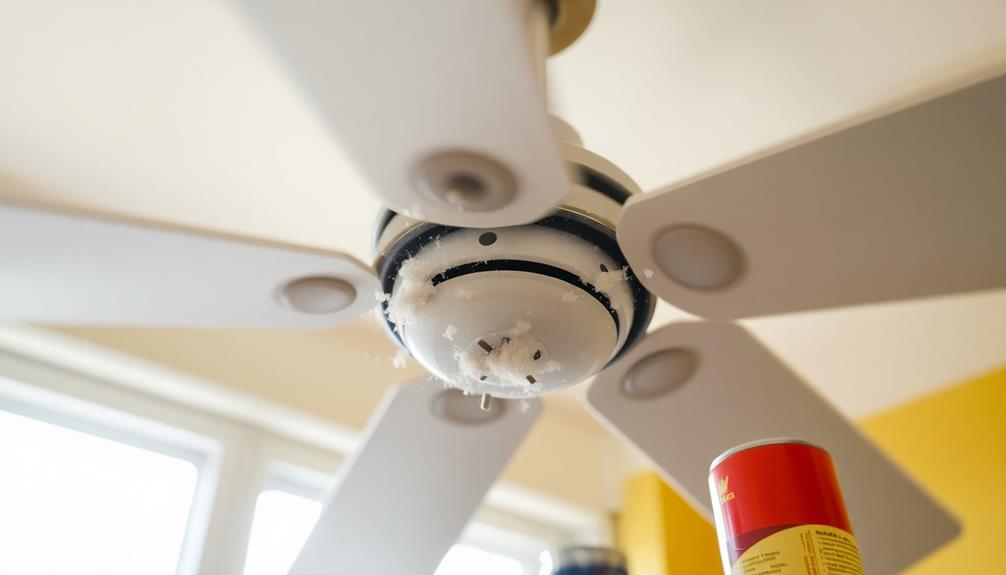
Regular maintenance plays an essential role in extending the life of your ceiling fan and preventing speed-related issues.
Start by regularly cleaning the fan blades and motor to eliminate dust and debris that can hinder performance.
Check the wiring connections for any signs of looseness or damage; secure them if needed.
Don't forget to inspect the capacitor for wear, as a faulty one can cause speed problems.
Monitor the fan for overheating, which may indicate underlying issues.
Additionally, verify the fan is installed according to manufacturer guidelines to prevent vibrations and noise.
Upgrading to Multi-Speed Fans
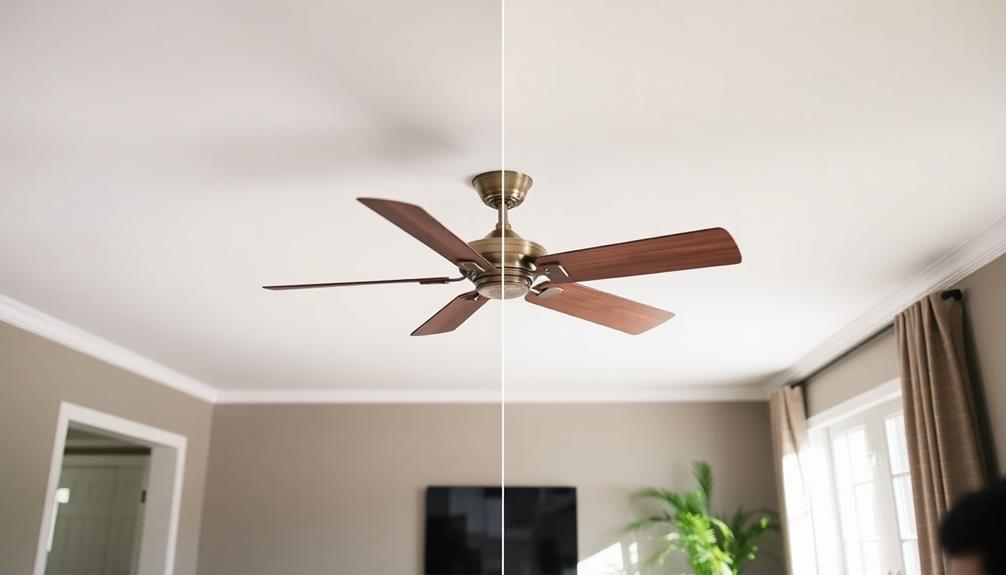
Upgrading to multi-speed ceiling fans can greatly enhance your comfort and energy efficiency. With adjustable settings, you can easily customize airflow based on your needs, whether you want a gentle breeze or a strong gust.
This flexibility not only keeps your space comfortable but also allows you to save on energy costs by using lower speeds when appropriate.
Additionally, multi-speed fans tend to experience less wear on motors, extending their lifespan. They come in various designs and styles, fitting seamlessly into your home's decor.
By choosing a multi-speed option, you can enjoy both functionality and aesthetics while avoiding the frustration of being stuck on high speed.
Make the switch today for a more enjoyable living environment.
Frequently Asked Questions
Can a Ceiling Fan Be Converted to a Multi-Speed Model?
Yes, you can convert a ceiling fan to a multi-speed model. You'll need to replace the existing switch, install a compatible speed controller, or upgrade the fan motor to achieve adjustable speed settings effectively.
What Tools Are Needed for Ceiling Fan Inspection?
Inspecting a ceiling fan's like peering into a mystery. You'll need a multimeter, screwdriver, and possibly pliers. These tools help you check wiring, test the capacitor, and guarantee everything runs smoothly for peak performance.
How Often Should I Clean My Ceiling Fan?
You should clean your ceiling fan at least once every three months. Regular dusting prevents buildup that can affect performance. If you notice excess dust or debris, clean it more frequently to maintain ideal airflow.
Is It Safe to Operate a Fan With a Faulty Capacitor?
It's not safe to operate a fan with a faulty capacitor. You risk electrical hazards, overheating, or further damage. It's best to address the issue immediately by inspecting or replacing the capacitor to guarantee safe functionality.
Can Environmental Factors Affect Fan Speed Performance?
You might think environmental factors don't matter, but they do impact fan speed. Humidity, temperature, and air pressure can affect motor efficiency, leading to inconsistent performance. Regular checks can help maintain ideal airflow regardless of conditions.
Conclusion
Don't let a ceiling fan stuck on high speed ruin your comfort! By following the troubleshooting techniques outlined, you can easily identify and fix the issue. You might think it's too complicated, but with a little patience and the right tools, you can restore your fan's functionality without calling a professional. Plus, regular maintenance can prevent future problems. Take control of your space again and enjoy the perfect breeze you deserve!
